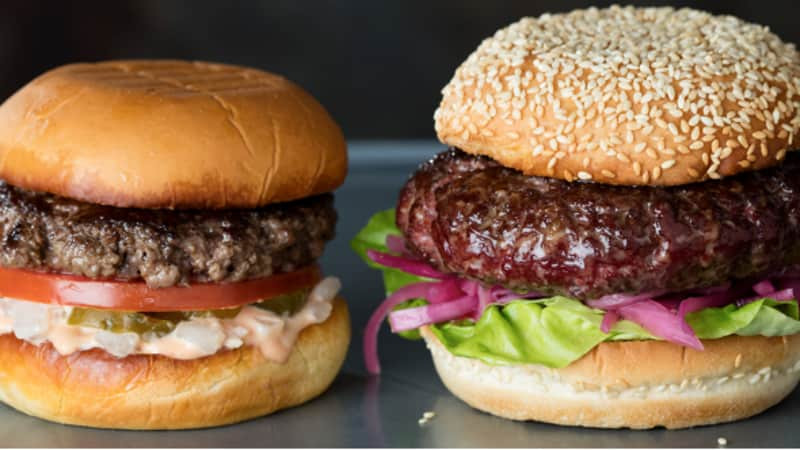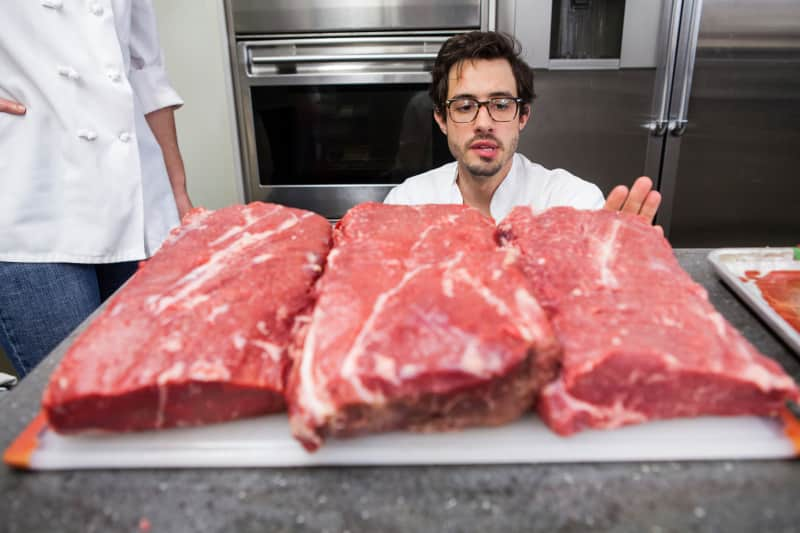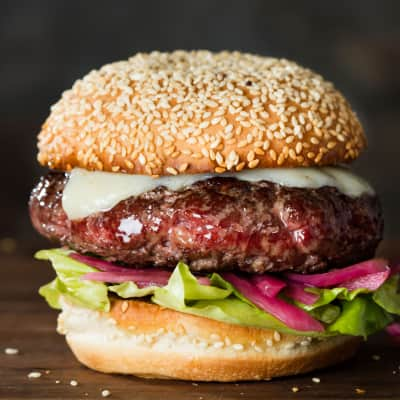While specific cuts have specific flavor profiles, there are a few other factors that influence the flavor of beef. They include cattle breed and age, the amount of exercise the animal gets, slaughter and storage conditions, and aging. And then there's diet. The vast majority of cattle raised for beef in the United States is grain-fed, but there's a growing demand for grass-fed beef. National retail sales jumped from $12 million in 2012 to $272 million in 2016, and more and more supermarkets, farmer's markets, and community-supported agricultural programs, as well as producers selling direct to consumers, are offering grass-fed options. We answer common questions about grass- and grain-fed beef to help you decide which is best for you.
The Differences Between Grass-Fed Beef and Grain-Fed Beef
Published July 16, 2019.


What Does “Grain-Fed” Mean?
Cattle that are placed in feedlots for the last 3 to 6 months before slaughter and fattened on a diet of grains (usually soy and corn based) are considered "grain-fed." (Such animals may also be called "grain-finished," since prior to being sent to feedlots, the cows existed on a grass or pasture diet.) Since the 1950's, the vast majority of cattle raised for beef in the United States have been fattened this way. Grains are higher in protein and starch, which not only helps the cow fatten faster, but makes the beef richer and fattier.
What Does “Grass-Fed" Mean?
Beef labeled "grass-fed" or "100 percent grass-fed," comes from cows that have eaten a grass or pasture diet for their entire lives. In order to use the label, producers must provide documentation to the Food Safety Inspection Service (FSIS) of United States Department of Agriculture (USDA), detailing the accuracy of their claims. (Note: The label "grass fed" does not necessarily mean the animals foraged outdoors for most of their lives; grazed on organic grass; or that antibiotics or hormones were omitted from the feed.)
Is Grass-Fed Beef Healthier Than Grain-Fed Beef?
Because of the difference in the cattle's diet, grass-fed beef is leaner than grain-fed beef. Dr. Susan Duckett, Professor of Animal Sciences at Clemson University, notes that grass-fed beef is also higher in certain vitamins, minerals, antioxidants, and omega-3 fatty acids. Furthermore, grass-fed beef also contains twice the amount of conjugated linoleic acid (CLA) isomers, a small family of fatty acids that purportedly fight cancer and lower the risk of diabetes. Why? Microorganisms that live in the gut of ruminants like cows restructure dietary fats, says Duckett. In particular, they transform linoleic acid into CLA—but only if the conditions are right. When a cow's diet is high in grain, the pH of its gut is lowered, making it a less friendly environment for these microorganisms. “Not so much with a foraged diet,” says Duckett. Cows that eat foraged grass have a gut with a higher pH. The microorganisms are happier. More CLA is created. “It's how it was meant to be.”
Which Tastes Better—Grass-Fed or Grain-Fed Beef?
Grain-fed beef has long been promoted as a richer and fattier option, while grass-fed beef has been criticized for its leanness, for being chewy, and for having a gamey taste. To judge for ourselves, we compared grass and grain-fed strip steaks and rib-eye steaks. Our tasters could not detect differences in the leaner strip steaks, but they did notice differences in the fattier rib-eyes: The grain-fed beef had a “mild” flavor, while the grass-fed steaks had more complex, “nutty” undertones. Interestingly, preferences were evenly split as to which option was better.
What accounts for the apparent turnaround in beef that used to be maligned? The answer may lie in new measures introduced in recent years that have made grass-fed beef taste more appealing, including “finishing” the beef on forage like clover that imparts a sweeter profile. Perhaps even more significant is that an increasing number of grass-fed beef producers have decided to dry-age (all of the steaks we tasted were dry-aged for 21 days). This process concentrates beefy flavor and dramatically increases tenderness in both grass-fed as well as grain-fed beef.

How to Shop for Grass-Fed Beef
Grass-fed beef is more expensive than grain-fed (in part because the animals take longer to reach slaughter weight and tend to be smaller than grain-fed cows). These tips will help ensure that you get the best quality for your money, and that you have a better understanding of exactly how the cattle was "grass-fed."
- Make sure the label says "grass-fed" or "100 percent grass-fed." Packaging that states qualifiers, such as "80 percent grass-fed" or "75 percent grass-fed," means the cattle's diet included some grain.
- Look for third-party verification. The FSIS doesn't make on-site inspections to confirm labeling claims, so a stamp of approval from an independent, third-party auditor like the American Grassfed Association or Food Alliance, which do carry out on-site inspections, can provide added assurance that the beef comes from animals that have only been grass-fed after weaning.
- Buy from producers who use “rotational grazing” or “management intensive grazing.” According to journalist Jo Robinson, who spent years studying grass-fed beef for her book Pasture Perfect, such practices mean that the farmers are working to produce lush, nutritious grass for their cattle to graze on—and therefore will be producing lush, nutritious, and tender beef, too. A stamp of approval from an independent auditor like the aforementioned American Grassfed Association or Food Alliance is also verification that such environmental practices are carried out, as well as standards around animal welfare. You can also ask the producer directly for confirmation.
- Look for marbling. A lean cut like the tenderloin will have little to no interior fat to speak of, whether the beef was grain- or grass-fed. But in fattier cuts, for optimal flavor, some fat needs to be present in the meat. And such marbling can vary widely, depending on the producer.
- Buy beef that's dry aged. Dry aging can intensify flavor and make grass-fed beef significantly more tender. (These same benefits apply to grain-fed beef.)
How to Cook Grass-Fed Beef
We’ve often heard that because it's leaner, grass-fed beef cooks faster than grain-fed beef. To put this claim to the test, we cooked seven grain-fed prime strip steaks alongside seven grass-fed strip steaks (grass-fed beef is not graded). Though the grass-fed steaks rose in temperature a bit more quickly than grain-fed in all but one of the tests, the difference between the quickest and the slowest steak was 4 minutes or less, and all of the samples cooked within our given time range.
The takeaway? Generally, you can cook grass-fed beef the same as grain-fed beef, but check its temperature at the beginning of a recommended time range.


